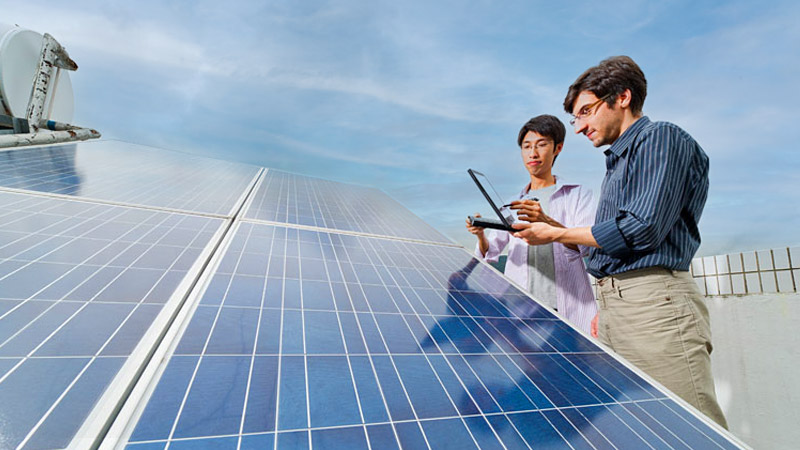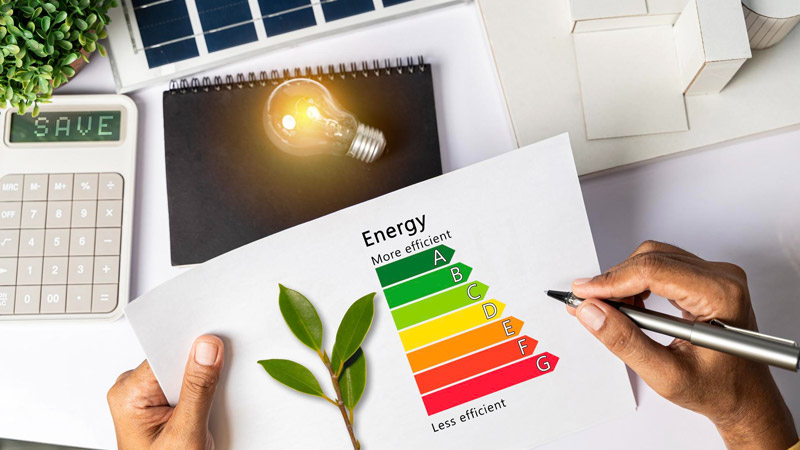Energy Efficiency: A pathway to Lower Carbon Emissions
City University of Hong Kong (CityUHK) is spearheading several initiatives to enhance energy efficiency in buildings, focusing on modern technological applications and comprehensive monitoring strategies. These efforts highlight CityUHK's comprehensive approach to improving energy performance and reducing energy consumption across its facilities.
In addition to building management, the University has also employed data-driven analytics for maintenance to optimise energy management processes.
By adopting sustainable and environmentally friendly practices, the university is setting a benchmark in energy efficiency and carbon reduction on campus.

Initiatives to Enhance Energy Efficiency and Processes to Reduce Carbon Emissions
Integrating Renewable Energy Sources
-
Application of Photovoltaic (PV) Panels
CityUHK has partnered with local power utilities to install thousands of PV panels on campus. These panels will generate up to 1.15GWh of electricity annually which is equivalent to the power consumptions of 280 households while reducing carbon emissions by about 450 tonnes each year. The project will also test innovative, electricity-free passive radiative cooling paint developed by i2Cool to enhance solar power generation efficiency.

Enhancing Energy Efficiency
-
Design Standards of Building Services Systems
CityUHK has established Design Standards of Building Services Systems for new buildings and renovation projects. The Design Standards Manual has been revised to incorporate advancements in building digitalisation. -
Upgrading Air Handling Units
CityUHK has been upgrading the air handling units (AHUs) with electronically commutated (EC) motor fans. This initiative forms part of a comprehensive strategy aimed at reducing energy consumption and improving operational efficiency. -
Implementing IoT Technology
Web-based Building Management Systems (BMS) and Internet of Things (IoT) technology enhance the flexibility of managing lighting and air conditioning systems through various IoT sensors, including motion sensors. The installation of IoT Fan Coil Unit (FCU) controllers allows for schedule control, temperature reset, and adaptive control. This approach has demonstrated a pay-back period of less than two years, making it a cost-effective solution for energy management. -
Predictive Maintenance to Chiller Plants
Predictive maintenance is applied to chiller plants. Maintenance and replacement of system components are based on key performance indicators (KPIs) rather than the number of years in service. This approach ensures that resources are allocated appropriately.

Reducing Energy Consumption
-
Adopting Smart Lighting Systems
All new renovations and constructions adopt LED lighting systems. When compared to fluorescent lighting systems, LEDs can reduce energy consumption by up to 50%. Furthermore, IoT motion sensors are incorporated to switch off LED lighting systems when areas are unoccupied, further minimising the energy usage.
Identifying and Minimising Energy Wastage
-
Web-based Monitoring System
The existing BMS systems, IoT devices, and Power Monitoring Systems are connected to form a single web-based BMS systems. Customised dashboards are developed to enable engineers for real-time monitoring and monthly energy analysis, which generates maintenance recommendations and ensures efficient energy management.

Adopting Innovative Technologies
-
Low-carbon construction techniques
The construction of the student Hostel (SH5) utilised Modular Integrated Construction (MIC) techniques, which significantly reduced the construction period by two years. Moreover, this approach minimised local waste and conserved materials used for concrete works, demonstrating a sustainable and efficient method in lowering carbon impact in construction.
Raising Environmental Awareness
- CityUHK actively promotes environmental awareness and education by offering workshops, training programs, and easily accessible resources to encourage eco-conscious behaviour among students, faculty, and staff. By creating a culture of environmental responsibility, the university encourages individuals to adopt greener lifestyles and contribute to collective efforts in combating climate change.
